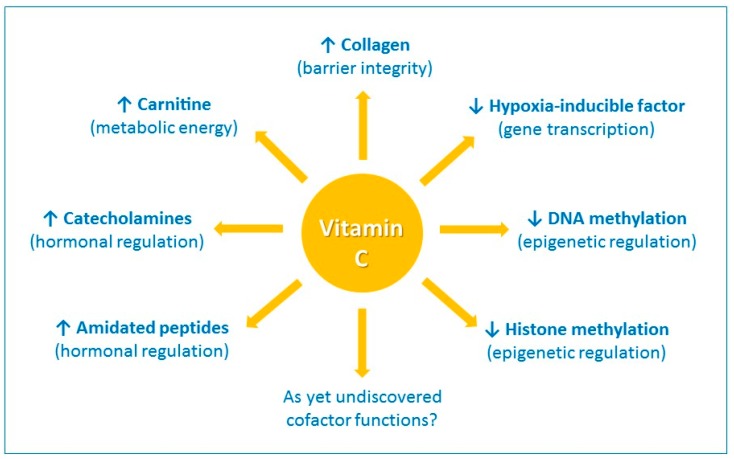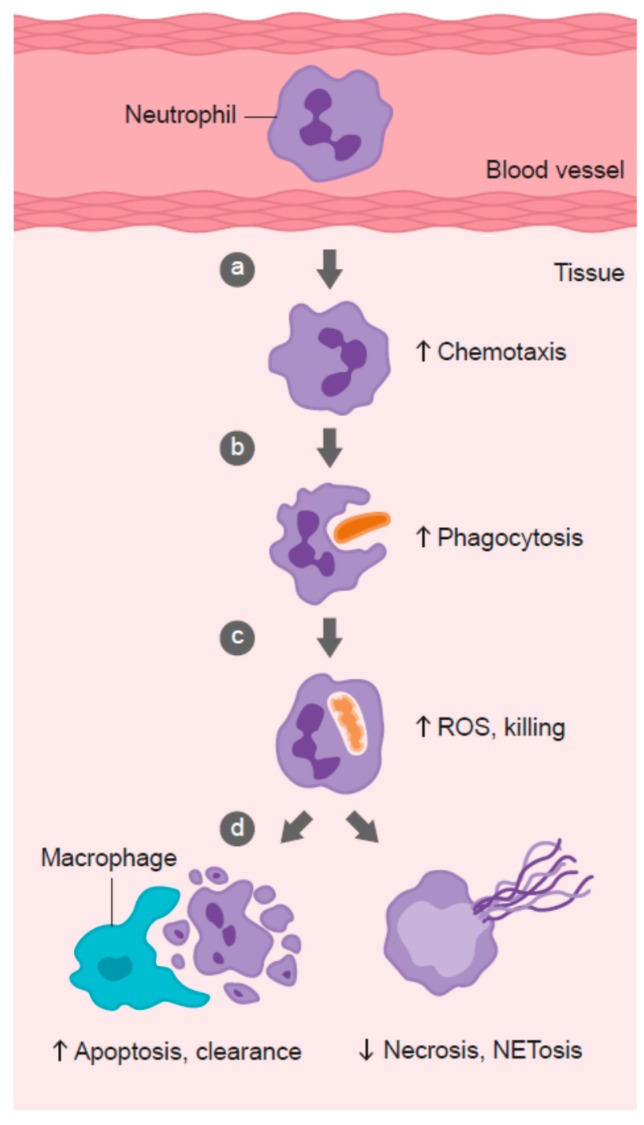Carr Anitra C., et al.
Nutrients, 2017
Abstract
Vitamin C is an essential micronutrient for humans, with pleiotropic functions related to its ability to donate electrons. It is a potent antioxidant and a cofactor for a family of biosynthetic and gene regulatory enzymes. Vitamin C contributes to immune defense by supporting various cellular functions of both the innate and adaptive immune system. Vitamin C supports epithelial barrier function against pathogens and promotes the oxidant scavenging activity of the skin, thereby potentially protecting against environmental oxidative stress. Vitamin C accumulates in phagocytic cells, such as neutrophils, and can enhance chemotaxis, phagocytosis, generation of reactive oxygen species, and ultimately microbial killing. It is also needed for apoptosis and clearance of the spent neutrophils from sites of infection by macrophages, thereby decreasing necrosis/NETosis and potential tissue damage. The role of vitamin C in lymphocytes is less clear, but it has been shown to enhance differentiation and proliferation of B- and T-cells, likely due to its gene regulating effects. Vitamin C deficiency results in impaired immunity and higher susceptibility to infections. In turn, infections significantly impact on vitamin C levels due to enhanced inflammation and metabolic requirements. Furthermore, supplementation with vitamin C appears to be able to both prevent and treat respiratory and systemic infections. Prophylactic prevention of infection requires dietary vitamin C intakes that provide at least adequate, if not saturating plasma levels (i.e., 100-200 mg/day), which optimize cell and tissue levels. In contrast, treatment of established infections requires significantly higher (gram) doses of the vitamin to compensate for the increased inflammatory response and metabolic demand.
Keywords
ascorbate; ascorbic acid; immune system; immunity; infection; lymphocytes; microbial killing; neutrophil function; vitamin C.
Conflict of interest statement
S.M. is employed by Bayer Consumer Care Ltd., a manufacturer of multivitamins, and wrote the section on ‘Vitamin C insufficiency conditions’. A.C.C. has received funding, as a Key Opinion Leader, from Bayer Consumer Care Ltd.Figures

The enzyme cofactor activities of vitamin C. Vitamin C is a cofactor of a family of biosynthetic and gene regulatory monooxygenase and dioxygenase enzymes. These enzymes are involved in the synthesis of collagen, carnitine, catecholamine hormones, e.g., norepinephrine, and amidated peptide hormones, e.g., vasopressin. These enzymes also hydroxylate transcription factors, e.g., hypoxia-inducible factor 1α, and methylated DNA and histones, thus playing a role in gene transcription and epigenetic regulation. ↑ indicates an increase and ↓ indicates a decrease.

Role of vitamin C in phagocyte function. Vitamin C has been shown to: (a) enhance neutrophil migration in response to chemoattractants (chemotaxis), (b) enhance engulfment (phagocytosis) of microbes, and (c) stimulate reactive oxygen species (ROS) generation and killing of microbes. (d) Vitamin C supports caspase-dependent apoptosis, enhancing uptake and clearance by macrophages, and inhibits necrosis, including NETosis, thus supporting resolution of the inflammatory response and attenuating tissue damage.
| PMID: | 29099763 |
|---|---|
| DOI: | 10.3390/nu9111211 |
| PMCID (Free PMC Article): | PMC5707683 |
| Category: | Immune |
The best supplements with Ascorbic Acid in Immune category:
- Vitamin C with Rose Hips (Rosa Canina), 500 mg, 110 Tablets (21st Century) - Vitamin C is an important antioxidant nutrient that supports the immune system. It contains among others: Ascorbic Acid.
- Abreve, Advanced Immune System Support Formula, 180 Vegetarian Capsules (Zahler) - Powerful Immune System Support. It contains among others: Ascorbic Acid.
- Junior C, Advanced Chewable Vitamin C, Natural Orange Flavor, 250 mg, 180 Tablets (Discontinued Item) (Zahler) - Antioxidant & Immune System BoosterVitamin C is an essential nutrient that functions as a powerful antioxidant. It contains among others: Ascorbic Acid.
- AllergEase, Immune System Support Formula, 90 Vegetable Capsules (Zahler) - Immune System Support FormulaZahler's AllergEase contains a unique combination of herbs and nutrients. It contains among others: Ascorbic Acid.
- Liposomal Vitamin C with Quali-C, 1,000 mg, 180 Vegetarian Capsules (Zenwise Health) - Zenwise Health® Liposomal Vitamin C is an antioxidant supplement that utilizes liposomal technology to ensure bioavailability of Vitamin C (Ascorbic Acid), an essential compound for the body. It contains among others: Ascorbic Acid.
- Green Tea Extract with EGCG + Vitamin C, 120 Vegetarian Capsules (Zenwise Health) - Zenwise Health Green Tea Extract features 725 mg of Green Tea Extract to support weight loss, energy levels, cognition, and cardiovascular health. It contains among others: Ascorbic Acid.
- C-500, 500 mg, 250 Tablets (21st Century) - Vitamin C is an important antioxidant nutrient that helps neutralize free radicals and supports the immune system. It contains among others: Ascorbic Acid.
- C-1000, Prolonged Release, 110 Tablets (21st Century) - Vitamin C is an important antioxidant nutrient that helps neutralize free radicals and supports the immune system. It contains among others: Ascorbic Acid.
- C, 500 mg, 110 Tablets (21st Century) - Vitamin C is an important antioxidant nutrient that supports the immune system. It contains among others: Ascorbic Acid.
- Max Strength Vitamin C + Superior Immune Booster, Orange Blast, 60 Vegan Gummies (Discontinued Item) (Zhou Nutrition) - Vitamin C+ gets an A+ in our book. It contains among others: Ascorbic Acid.
- Vitamin C, 250 mg, 110 Tablets (21st Century) - Vitamin C is an important antioxidant nutrient that supports the immune system. It contains among others: Ascorbic Acid.
- Vitamin C, 1,000 mg, 90 Tablets (Solgar) - Vitamin C is a water-soluble vitamin that helps fight free radicals, which can lead to oxidative stress and the premature aging of cells. It contains among others: Ascorbic Acid.
- Ester-C Plus, Vitamin C, 1,000 mg, 90 Tablets (Solgar) - Ester-C Plus is exclusively formulated by Solgar and provides a patented, pH neutral (non acidic) Vitamin C that is gentle on the stomach. It contains among others: Ascorbic Acid.
- Ester-C Plus, Vitamin C, 500 mg, 100 Vegetable Capsules (Solgar) - Ester-C Plus is exclusively formulated by Solgar and provides a patented, pH neutral (non acidic) Ester-C Vitamin C that is gentle on the stomach. It contains among others: Ascorbic Acid.
- Immunity 911 - Extra Powerful Ingredients for Your Stronger Immunity -
Immunity 911 - Advanced Immune Boster Formula Your First Line Of Defense Against Infection!
Viruses are floating all around us, ready to filter into our body any moment completely unnoticed. It contains among others: Ascorbic Acid. - Immune Defence - Zinc Lozenges with Rosehip and Acerola - Your immune system needs daily support to stay in good form, to be able to fight off any pathogens trying to enter your system and to witstand the impact of stress on your body and mind. It contains among others: Ascorbic Acid.
- Biotin, 1000 mcg, 100 Capsules (Now Foods) - Biotin is a water-soluble vitamin necessary for normal growth and body function. It contains among others: Ascorbic Acid.
- Cheers - Vitamin C - The Best, Highly Bioavailable And Natural Vitamin C. It contains among others: Ascorbic Acid.
Articles similar to "Vitamin C and Immune Function."
- The role of Ascorbic Acid in Immune: The Effects of Oral Supplements With Sambucus Nigra, Zinc, Tyndallized Lactobacillus Acidophilus (HA122), Arabinogalactans, Vitamin D, Vitamin E and Vitamin C in Otitis Media With Effusion in Children: A Randomized Controlled Trial. (Objective: To evaluate the ability of oral supplements with immune-stimulating molecules (Sambucus nigra, Zinc, Tyndallized Lactobacillus acidophilus (HA122), Arabinogalactans, vitamin D, vitamin E and vitamin C) to reduce the inflammation of the upper airway tract and improve the outcome of otitis media with effusion (OME) in children... OS with immune-stimulating molecules should be considered as a supporting therapy in children affected by recurrent episodes of UAI associated with OME due to their capacity to improve the immune response and reduce the inflammatory phenomena. OS can improve the fibroendoscopic findings by restoring middle ear ventilation, in addition to their ability to reduce inflammation in the middle ear.)
- The impact of Ascorbic Acid on Immune: Role of Vitamins D, E and C in Immunity and Inflammation. (Inflammatory responses are operationally characterized by pain, redness, heat and swelling at the site of infection and trauma... OS with immune-stimulating molecules should be considered as a supporting therapy in children affected by recurrent episodes of UAI associated with OME due to their capacity to improve the immune response and reduce the inflammatory phenomena. OS can improve the fibroendoscopic findings by restoring middle ear ventilation, in addition to their ability to reduce inflammation in the middle ear.)
- The significance of Ascorbic Acid for Immune: Immune-enhancing Role of Vitamin C and Zinc and Effect on Clinical Conditions. (Vitamin C concentrations in the plasma and leukocytes rapidly decline during infections and stress... OS with immune-stimulating molecules should be considered as a supporting therapy in children affected by recurrent episodes of UAI associated with OME due to their capacity to improve the immune response and reduce the inflammatory phenomena. OS can improve the fibroendoscopic findings by restoring middle ear ventilation, in addition to their ability to reduce inflammation in the middle ear.)
Previous article
Next article
Vitamin C and carotenoids in organic and conventional fruits grown in Brazil.

























































